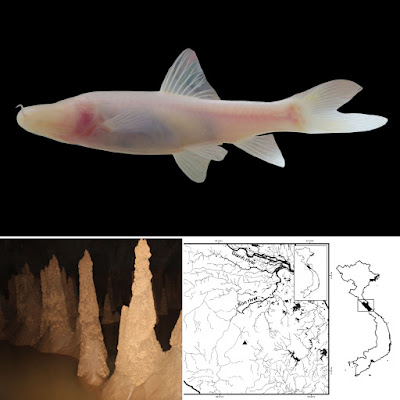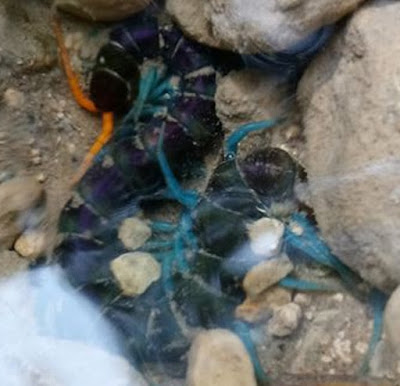[Most Recent Entries] [Calendar View]
Monday, September 24th, 2018
| Time | Event | ||||||
| 9:37a | [Ichthyology • 2018] Speolabeo hokhanhi • A New Cavefish (Teleostei: Cyprinidae) from Central Vietnam
Abstract Speolabeo hokhanhi, new species, is here described from Hang Va Cave in Phong Nha-Ke Bang National Park (Son River basin) in Central Vietnam. It can be distinguished from S. musaei by having no papillae on the lower lip, no hump immediately behind the head, a duckbilled snout, a shorter caudal peduncle (length 16.8–18.6% SL), and the pelvic fin inserted closer to the snout tip than to the caudal-fin base. Keywords: Pisces, Speolabeo, new species, cavefish, Central Vietnam
Speolabeo hokhanhi sp. nov. Diagnosis. Speolabeo hokhanhi can be easily distinguished from S. musaei by having a lower lip without papillae (vs. with a band of papillae along its anterior margin), no hump immediately behind the head (vs. present), a duckbilled (vs. pyramidal) snout, the pelvic fin inserted closer to the snout tip than to the caudal-fin base (vs. midway between the snout tip and caudal-fin base) and a shorter (vs. longer) caudal peduncle (length 16.8–18.6% SL vs. 19.6–22.7). All data here used for S. musaei are from Kottelat and Steiner (2011). .... Etymology. The specific epithet is named in honor of Mr. Ho Khanh who discovered many caves in Phong Nha–Ke Bang National Park. He was a local guide of the cavefish survey conducted by the first author during 2014 into the cave where the type specimens were collected and provided detailed information about the collection site. As common names, we suggest Hokhanh’s Blind-cavefish (English) and cá mù hang va hồ-khanh (Vietnamese).
Distribution and habitat. Speolabeo hokhanhi is known only from the type locality (Fig. 4). Hang Va Cave is roughly 35 km south of Phong Nha village, rather close to Hang Son Doong, the world’s largest known cave that is 5 km long, 200 m high and 150 m wide. A 24 km southward drive along the West Ho–Chi–Minh highway starting from the tourism center of the Phong Nha–Ke Bang National Park leads to the point closest to the cave site of the Hang Son Doong. From there, roughly 1.5 hours’ northward walk following a narrow stony track through thick forest arrives at Hang Va Cave. Its entrance is about 30 meters above the ground. A descent of 15 m from the entrance reaches a cave passage containing a subterraneous stream. Downstream for approximately 200 meters, there is a shallow water pool with many stalagmites, usually 2–3 m tall (Fig. 5), where the type specimens of the new species were collected during the dry season. At this time, the pool had a muddy substrate and was 0.5–1.5 m in depth, 10 m wide, and 25 m long. More than 30 individuals of about the same size were observed in the pool; only six were captured using a hand-net. The fishes were swimming slowly and haphazardly, rather close to the water surface; when disturbed, they swam deeper, but did not seek shelter. A new shrimp species was found to sympatrically occur with the cavefish (Do & Nguyen 2014). Nguyen Dinh Tao, Liang Cao, Shuqing Deng and E Zhang. 2018. Speolabeo hokhanhi, A New Cavefish from Central Vietnam (Teleostei: Cyprinidae). Zootaxa. 4476(1); 109–117. DOI: 10.11646/zootaxa.4476.1.10 | ||||||
| 9:48a | [Chilopoda • 2018] Scolopendra paradoxa • A Phylogenetic Approach to the Philippines Endemic Centipedes of the Genus Scolopendra Linnaeus, 1758 (Scolopendromorpha, Scolopendridae), with the Description of A New Species
Abstract The genus Scolopendra Linnaeus, 1758 is represented in the Philippines’ fauna by five species, two of which are endemic. Mitochondrial DNA sequences of gene cytochrome c oxidase subunit I (COI) were obtained from six Scolopendra specimens belonging to two endemic species and a new one, described here as Scolopendra paradoxa Doménech sp. nov. These sequences were analyzed together with another forty-one sequences from GenBank, including additional species of Scolopendra and a few representatives of other Scolopendridae genera. Phylogenetic trees inferred from the COI analysis using maximum likelihood and neighbor joining showed the three Philippines Scolopendra endemic species as a polyphyletic group coherent with their respective morphologies, although the position of S. spinosissima Kraepelin, 1903 varied within the obtained trees. Species delimitation based on standard external morphological characters was also concordant with the observed genetic distances, monophyly and node support, confirming S. subcrustalis Kronmüller, 2009 and S. paradoxa sp. nov. as separate species also at the molecular level, while only the position of S. spinosissima could not be properly established with any of the statistical methods used. In addition, the male genitalia of the three studied species were found to lack gonopods and a penis. Remarks on the ultimate legs prefemoral spinous formula of S. spinosissima plus a key to the species of the genus Scolopendra in the Philippines are provided. Keywords: Myriapoda, Chilopoda, scolopendromorph, Scolopendra paradoxa, Scolopendra spinosissima, Scolopendra subcrustalis, barcode, cytochrome oxidase I
Family Scolopendridae Newport, 1844 Subfamily Scolopendrinae Kraepelin, 1903 Genus Scolopendra Linnaeus, 1758 Scolopendra paradoxa Doménech sp. nov. .... Etymology. From “paradoxon”, meaning contradiction, because the new species’ author initially identified this new taxon as a color variant of S. spinosissima. Nevertheless, the genetic divergence between these two species contrasted with earlier identifications. Suggested common name. Philippine’s cyan leg centipede. Carles Doménech, Victor M. Barbera and Eduardo Larriba. 2018. A Phylogenetic Approach to the Philippines Endemic Centipedes of the Genus Scolopendra Linnaeus, 1758 (Scolopendromorpha, Scolopendridae), with the Description of A New Species. Zootaxa. 4483(3); 401–427. DOI: 10.11646/zootaxa.4483.3.1 |
| << Previous Day |
2018/09/24 [Calendar] |
Next Day >> |





